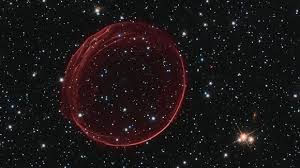THE QUANTUM VACUUM AND THE DESTRUCTION OF THE UNIVERSE
- planck
- Aug 10
- 6 min read
Modern physics is replete with physical and mathematical concepts and phenomena so alien to our everyday experience that they seem to have no connection to our reality. Furthermore, in fundamental physics, many theoretical models are so abstract and complex that they are very difficult to understand. Because of this, it is sometimes easy to forget that our macroscopic world is absolutely dependent on what happens at the fundamental level, and at this level, the world is described by "physical and mathematical" laws, such as those underlying the Standard Model of particle physics. In this article, we will see how important it is to understand these fundamental laws to understand our place in the Universe and why we are here. We will also discover how some of these "abstract concepts," such as the concept of the vacuum state of a quantum field, not only directly influence our real world but can also determine the fate of the Universe we inhabit.
Below, we will try to explain simply, without complicated formulas, how the stability of our Universe is not guaranteed. In fact, there is a real possibility that our vacuum is actually a false vacuum state and could undergo a transition to a true vacuum state. This would mean, nothing more and nothing less, than the destruction of the Universe as we know it and the emergence of a new Universe, most likely incompatible with the emergence of any kind of life.
The quantum vacuum of our Universe
Our Universe, at a fundamental level, is made up of quantum fields whose vibrations constitute all the particles we know. The state of "minimal vibration" is called the vacuum state of the field and is not a state of zero energy but a state of minimum energy.
The so-called Standard Model (SM) contains practically everything we know about particle physics. In fact, this theory is undoubtedly one of the greatest achievements of human knowledge, and its ability to predict how our (quantum) world works is absolutely breathtaking. This theory is a quantum field theory in which, as we have said, the fundamental components are fields that oscillate or "vibrate." Of all the fields in the SM, there is a special one, one that permeates all of space-time, similar to the "force" field in Star Wars :D
This force field determines the characteristics of all other known particles and therefore allows for our existence. Let's visualize the shape of this extraordinary field below:

The total energy of a quantum field has two components that we can call kinetic energy and potential energy. The x-axis and y-axis represent the value of the kinetic energy and the z-axis the value of the potential energy. If we look at the graph above, we see that at point A the field has kinetic energy 0 and potential energy V. Fields always tend to "roll" toward the point of minimum potential, which is why the field at point A is unstable: at a given moment, due to a quantum fluctuation or the tunneling effect, the field will "jump" from point A to point B. At point B, something "curious" happens: the field potential is 0 but the value of the field is 246 GeV. In case you haven't guessed yet, this "force field" is the Higgs field. When the average energy of our Universe dropped below 246 GeV, the "force field" jumped from point A to point B. This process fixed the vacuum value of the Higgs field, which determines the SM vacuum and therefore the current vacuum of our Universe.
Quantum tunneling to destruction
Next, we'll ask two crucial questions: Can we know the complete shape of the potential of the "force" field? If we continue exploring the graph for very large values of the x-axis, what shape would the graph have? The answer to the first question is yes. The answer to the second is as follows:

Point B represents the current vacuum of our Universe and corresponds
with point B of the previous graph
The fundamental fact is that beyond a certain field value, the potential reaches a maximum, then drops again, and becomes negative! This makes it possible for a new vacuum value to exist , lower than the current value! Let's look at this in more detail.
The shape of the "force field" potential is determined by a value called the coupling constant (lambda). When we calculate what happens to this value as the energy increases, we discover something truly alarming:

For energies of the order of 10exp10 GeV, the value of lambda becomes negative! This means that the potential of the field has a lower value than the actual one, and therefore , the vacuum of our Universe is not stable!

This is because if the Higgs field potential has a minimum below the SM minimum, there is a possibility that, due to quantum fluctuations or tunneling, the current vacuum state could "jump" to the new vacuum state. This phenomenon would have totally disastrous effects: the new vacuum state would begin to expand at the speed of light, destroying everything in its path. The pressing question is: Can we calculate the possibility of such a transition?
The probability of the end of the Universe
The tunnel transition probability at a potential barrier is given approximately by:

where hI is the field value in the instability region and S4 is the action associated with the tunnel transition probability. For a negative potential like the one in the graph above, S4 is approximately:

Then the transition probability is given by:

To find the probability per unit of time and unit of volume we must multiply this value by the four-dimensional space-time contained in the current size of the Universe, which is approximately the fourth power of the age of the Universe:

This value is much larger than the observed value of hi (approximately -0.01) so the transition probability is much smaller than the age of the Universe:

Fortunately, the probability of the destruction of the Universe is very, very small!
This means that our Universe isn't actually unstable, but rather metastable. However, this metastability is quite "strange," as it appears that our Universe is in a very critical range between stability and instability. To see this, let's look at this graph:

Why does our Universe seem to be in such a special zone? Let's look at this other graph:

Again, intriguingly, our void seems to be in a fine balance between stability and instability.
It is important to highlight a very important fact, the calculation we have performed to calculate the stability of our vacuum makes a key assumption: it assumes that the SM is valid at all energy scales, however, if this is not the case this calculation can be drastically modified .
Gravity, stability and new physics beyond the standard model
There are experimentally proven phenomena, such as the mass of neutrinos, dark matter, and dark energy, that clearly point to the existence of physics beyond the SM. The existence of new physics would cause the stability of our vacuum to change drastically. The effects of the new physics could make the Universe more stable or more unstable. For example, the existence of a high-mass right-handed neutrino, predicted by many models, would be catastrophic: stability would drop alarmingly. Since we know that the half-life of the transition cannot be much less than the age of the Universe (otherwise we wouldn't be here), this implies an upper limit on the mass of these neutrinos. On the other hand, there is work indicating that a force not included in the SM, gravity, may contribute to the stability of our Universe.
This means that studying the stability of the Universe can help us analyze the probability of the existence of new physical phenomena beyond the SM.
Conclusions
For us to be here reading this (the few people who read these things), a number of truly extraordinary phenomena must have occurred. The Universe we see is actually the "ashes" of events that occurred at extremely high energies. One of these fundamental events occurred at "only" 246 GeV: a force field underwent a phase change and produced the mass of many of the particles we see. This force field, which had the power to facilitate our existence, also has the capacity to end it. As we have seen, the object of study of high-energy physicists drastically influences our everyday world, and therefore, its study is not only of theoretical interest.
Sources: Vacuum Stability and the Higgs Boson





Comments